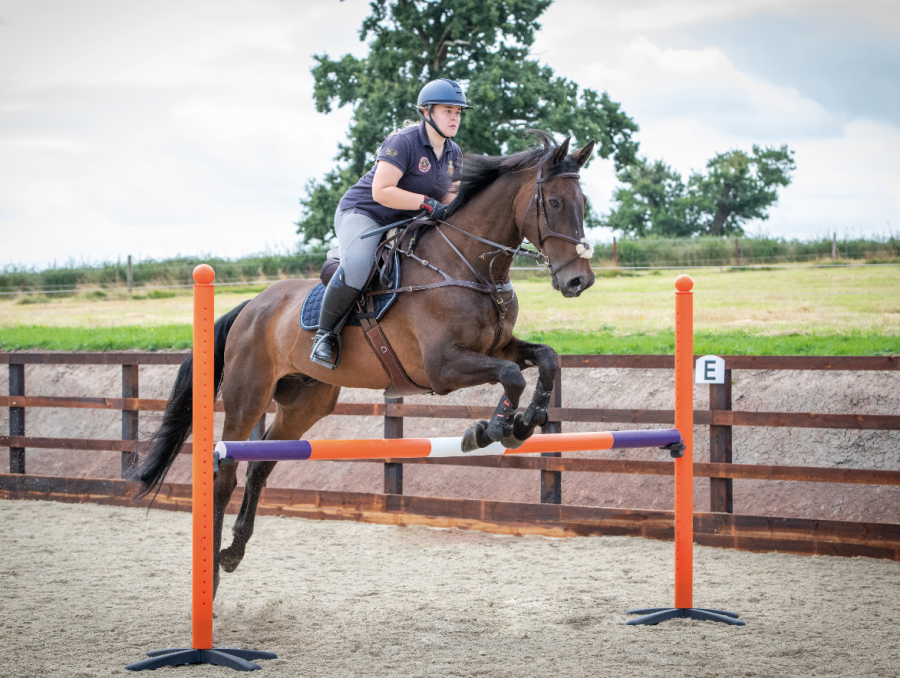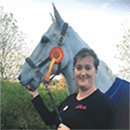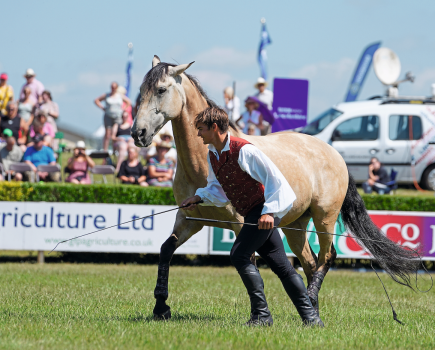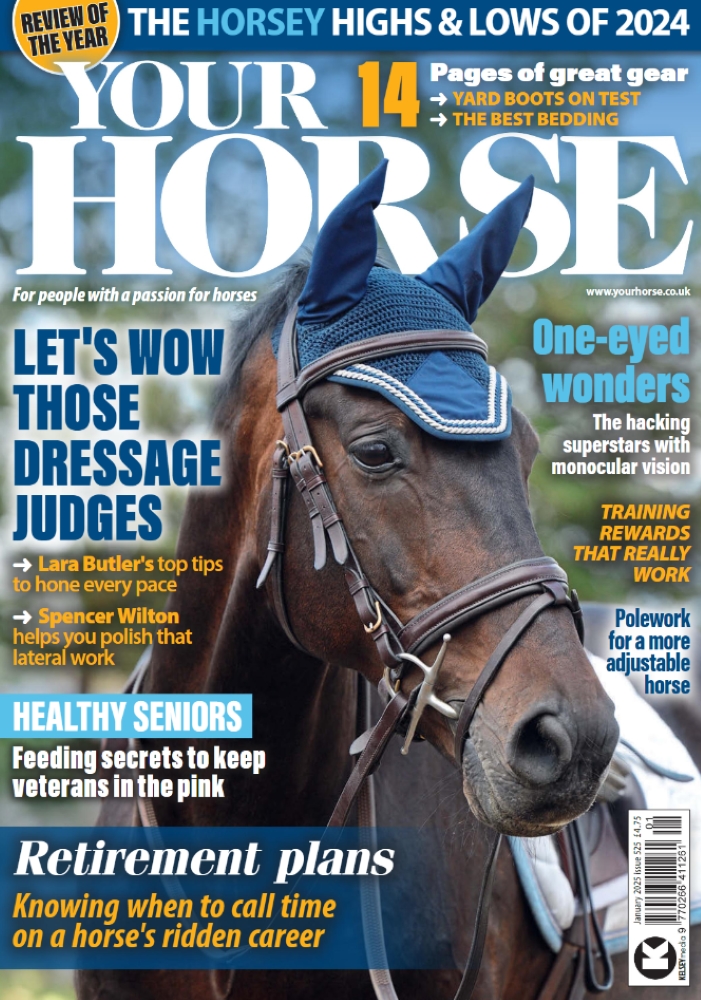When did you last trot to a fence? Canter is usually the preferred choice for finding the perfect take-off spot, but according to Burghley 2022 winner Piggy March, it is useful to regularly try jumping out of trot too — and be prepared for it to feel untidy.
This is a training exercise that Piggy regularly uses at home with her own horses. It tests rider balance and helps achieve an agile, rideable horse.
Piggy demonstrated the training exercise at Your Horse Live. It requires five poles, five sets of jump wings and your imagination, because there are dozens of lines to ride as you work on honing you and your horse’s skills — and you’ll benefit hugely from doing it in trot.
“This is a brilliant exercise that I use at home. I do it with horses of all levels,” says Piggy.
“Some days I’ll be brave with how high the fences are that I trot at. I do it to push me; trying to keep in balance over that extra bit of height. I’ve done this exercise for years and it’s one I keep doing in order to work on myself.
“Every time I do it on a new horse I feel all over the place because they’re not used to it. So don’t panic if something goes wrong or it’s not quite feeling how it’s meant to — just keep going,” adds Piggy.
“With all disciplines being so technical these days, basic training all rolls into one, whether you’re on the flat, jumping or riding across country. I want a nicely trained and happy horse who is rideable.
“This exercise works on the rider’s balance and the horse’s, as well as mobility and trainability — all the things you need to have for a confident, rideable horse.”
Piggy’s training exercise 1: snaking in and out
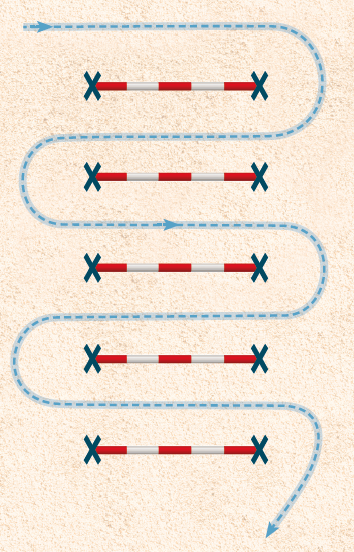
Set up five uprights without ground lines down the middle of your training field or arena with each fence on a one-stride distance.
After warming up, start trotting your horse between the obstacles, varying the direction that you ride in, changing the rein and alternating which fences you ride between.
“Turn one way and then the other, so that you start to feel like the horse is working with you and like you’re getting bend around their ribcage,” explains Piggy, who says that you shouldn’t worry about your horse working in a perfect outline while doing this.
You won’t be looking like you’re about to go into a dressage test, because you’re doing lots of bending and you’ve got longer reins.
“This is just an exercise to get the horse really loosened up, on the aids and working with you,” explains Piggy, “but you can also make it what you want it to be. When your horse feels ready, you can get your reins together a bit more and vary the outline they’re working in.”
Exercise 2: transitions between fences
Next start asking for transitions between the fences. Start with trot-walk and walk-trot.
“Imagine there is a centre line up the middle of the fences and do a trot-walk transition every time you cross over the centre line,” says Piggy.
“Think about your balance and preparation. Around the corner you should already be thinking about slightly bringing your upper body back and looking for your straight line.
“Even though it’s a downward transition, it still needs to be forward. You’re preparing it early and through body-seat language.
“If you can get your horse to respond to you rather than going to the bridle [that is, pulling on the reins] it will be a forward transition, which is what you want,” continues Piggy.
“A bad transition stops the forward momentum. It happens when it’s left to the last minute rather than being prepared for and is an afterthought of walk.”
Introduce canter transitions
Move on to riding trot-canter and canter-trot transitions every time you cross the centre line.
Depending on the level you and your horse are working at, you could do walk-canter and canter-walk transitions too. Advanced horses can do flying changes instead.
“Some horses anticipate. If I’m on one like that I just quietly keep doing the exercise until he relaxes and stays on an aid for me,” says Piggy.
Make sure your horse is straight in their body and has enough room for the transition too. A few extra steps of the pace you’ve changed into is better than doing only two or three and rushing the transition, for example.
Also don’t let the horse get in front of you — they must wait for the aid.
“You’re doing this because you want the horse to become sensitive to your body language [so that they start to slow down and wait when they feel your upper body sit up],” explains Piggy.
Piggy’s training exercise 3: trot to a fence
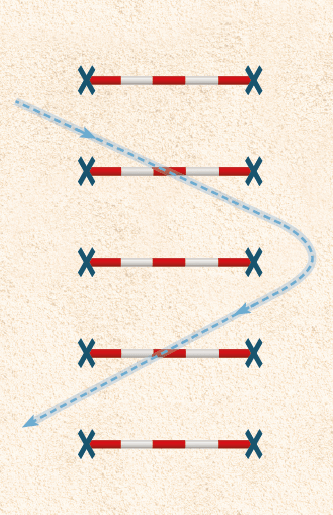
Approach one of the fences in your line of five in trot and jump it at an angle.
“I don’t particularly like jumping out of trot because it’s not as comfortable [as canter] and it can get ugly,” confesses Piggy.
“That’s why I make myself do it; it works on the rider’s own balance and builds trust between you and your horse that they can stay on a line at this pace. It’s slow but the horse is in front of your leg; you’re trusting that your horse will stay on a line and you’re learning to stay with it.
“Trotting to a fence can be ugly if they get in too close; it’s not an obvious stride like you get with canter. They can pick up [to jump] early and so you have to slip the reins and try not to fall off the back, or sometimes you get in front of them and then they don’t go.
“Even on a horse who has done this before, it doesn’t mean they’re going to do it very well the next time you try,” continues Piggy.
“I don’t mind if they knock it down; it’s about learning patience, having balance and staying in a rhythm.”
If your horse lands in canter, quietly ask them to trot again before approaching the next fence. Piggy says the aim is for you as the rider to stay in neutral, putting your horse on a line in the best rhythm and then trusting them to jump the fence.
Next steps
Move on to jumping more than one fence but continuing to jump at an angle. Fence two to fence four for example.
“The fences can be as small as you like but try to stay in trot. It doesn’t matter which way you do which fence — vary the lines,” advises Piggy.
Piggy’s training exercise 4: try it in canter
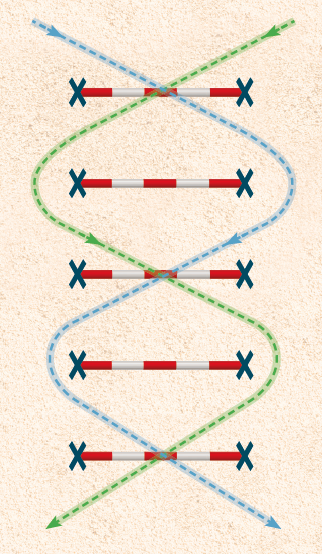
When you’re ready, repeat the previous exercise in canter and try three fences in a row, for example fences one to three and then five.
If your horse can make a flying change each time you change direction, great. If not, give yourself time to make a change through trot.
You can also indicate which leg you want to land with leading by pushing your weight down into that stirrup over the previous fence.
“With a horse who has a weak canter I sometimes jump the first fence and then circle, so that I get a bit of bend through their body, and then do the same before the last fence.
It encourages them to try and find their balance. After a couple of times, they start picking up what’s happening.”
The final stage is to jump down the grid in a straight line.
“You can go as big or small as you like with the fences, but don’t put them all at the same height. Vary them, even if its only a little difference, so the horse has to look and gauge what height is where.”
Jump it in the other direction too and approach off both reins.
“There’s no rules for this exercise, make it up as you go, as long as you’re in your comfort zone,” adds Piggy.
“It really is such a good exercise to set up at home because there’s so much you can do with it. You can work on yourself and your horse in so many ways.”
How high are Piggy’s fences?
The key to this exercise is that you can adapt it to suit you and your horse. Lacking confidence or on a green or young horse? Then ride wider lines to each fence and don’t try to link together too many that are close together.
Choose a height that is best for you both too: whether it’s poles on the floor or 2’3”, it’s better to start small and build up the height and technicality as you become more confident.
Start small even if the exercise isn’t new to you too, and remember that horses learn through repetition, so making this exercise a regular part of your routine will benefit you both hugely.
“Training’s not about how high you can jump or how fast you can go, it’s knowing what’s right for you,” reasons Piggy. “Even smaller ones out of trot can feel quite big.”
Why doesn’t Piggy use a ground pole when training?
Piggy chooses to set this exercise up without ground lines on any of the fences.
“I don’t really know why I don’t have them; it doesn’t feel as inviting and is a little upright — but cross-country fences these days are more upright so this is good practice. And you know what? Horses generally jump very well without a ground rail being there.
“Yogi Breisner did this exercise with me probably 10 years ago and he didn’t use ground rails; I found it interesting and I haven’t used them myself.”
However, if she were riding a particularly young or inexperienced horse, Piggy would consider adding in ground lines.
“If it’s a real baby and I want them to get used to the exercise then I probably will put a ground rail in to start because I want to keep them confident. Otherwise it’s really personal preference of ground rail or no ground rail.”
Find out more about Piggy March here
Main image © Your Horse Library/Sally Newcomb. Diagrams © Your Horse Library/Geoff Johnson Design. NB: Piggy March is not pictured riding.

